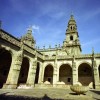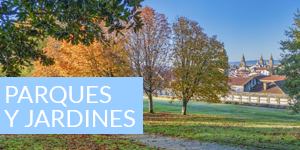- Accede I
- Regístrate I
- carrito
La gran historia de la Catedral de Santiago
Esta Catedral que hoy ves tiene en su parte más antigua más de mil años. Pero los acontecimientos que le dieron origen se remontan mucho más atrás, a los tiempos mismos de la muerte de Jesús.
Todo comenzó cuando uno de los apóstoles más importantes, Santiago el Mayor, fue ejecutado en Palestina en el año 44. Sus seguidores decidieron enterrarlo lejos de allí y se embarcaron en un viaje rumbo al Fin del Mundo. La historia del traslado del cuerpo del Apóstol la puedes leer aquí. ¡Es realmente asombrosa!
Como resultado de este milagroso viaje, el Apóstol fue enterrado en un monte mágico llamado Libredón. Su tumba quedó en el olvido… hasta que una noche de hace 1.200 años se produjo su descubrimiento. El rey se dio cuenta de que allí estaban las reliquias de un apóstol de Cristo y mandó a construir una iglesia, el siguiente rey otra mayor… pero siempre se iban quedando pequeñas porque comenzaban a llegar muchos peregrinos informados del milagro. Vinieron monjes, mercaderes y campesinos y Compostela empezó a crecer en el siglo X. Y así llegamos al año 1075, cuando por fin se ponen las primeras piedras de la gran Catedral de peregrinación que hoy conocemos.
A partir de ese año desfilarían por Santiago los mejores constructores del Románico hasta llegar al Maestro Mateo, autor de los últimos tramos de las naves y, sobre todo, del Pórtico de la Gloria, la joya que preside la entrada oeste.
Cuando fue consagrada en el año 1211, la Catedral ya gozaba de un privilegio increíble: todo aquel que visitase la Catedral en un Año Santo vería perdonadas las penas de sus pecados. ¡Y eso en la Edad Media era muy importante!
Con el tiempo las obras no se detuvieron en la Catedral. Santiago era una ciudad rica en propiedades y podía permitirse tener la iglesia más hermosa para el Apóstol, que fue nombrado patrón de España en 1630. Así se fueron añadiendo y cambiando las capillas y enriqueciendo los retablos. En los tiempos del arte gótico, la Catedral se disfrazó de fortín con torres y almenas. Pero la mayor revolución llegó con el Barroco, el elegante estilo que hoy vemos en el altar mayor, en la fachada del Obradoiro y en las plazas monumentales que rodean a la Catedral. Lo distinguirás por sus volutas de piedra, sus ristras de flores y frutas, sus calados geométricos en el duro granito, unas cornisas erizadas de pináculos, sus poderosas chimeneas y sus estilizadas torres… ¡Santiago es muy, muy barroco!
En definitiva, estás en una Catedral milenaria, con una riquísima historia. Aquí se han coronado reyes y arzobispos; se han producido incendios y batallas; se han acuartelado soldados invasores y se han arrodillado millones de hombres y mujeres llegados de todas partes del mundo. La Catedral es el corazón de la historia de la ciudad de Santiago. Y con un poquito de imaginación, podrás leer todos esos maravillosos sucesos en la piedra.















